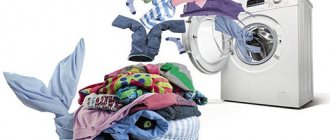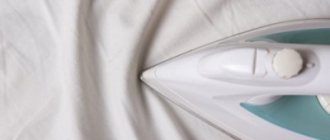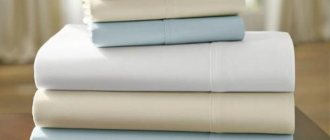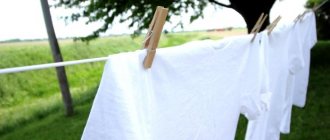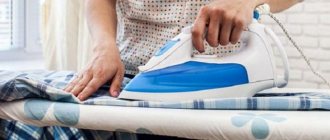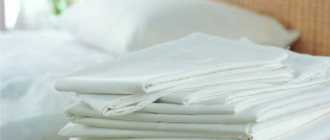One of the most mysterious phenomena that humanity is still trying to unravel is night dreams. Our dreams have a very different storyline, it is very rare when it can be repeated. Dreams that occur from Thursday to Friday are especially arousing; they are considered prophetic.
From a psychological point of view, the subconscious dialogues through dreams. Therefore, more often than not, our subconscious gives us the desired reality in night dreams.
Each plot has its own interpretation. Dreams in which bed linen appears are no exception. Its meaning depends not only on the appearance of bedding and items from your wardrobe, but also on your actions. You will find out the answer to the question of why you dream of washed clothes by reading the article to the end.
“Unwashed” or “unwashed” - which is correct?
Which is correct: “not washed” or “unwashed”?
The word “erased” is a verbal adjective formed from the unprefixed verb - what to do? - wash. The fact that this word is not a participle is told to us by the suffix in the word - “-en”. In the participle “erased,” the suffix “-enn” is written, and it should be distinguished from the adjective “erased.”
The word is written according to the general grammatical rules for writing the particle/prefix “not” with adjectives.
That is, we write together with the prefix “not-”, when the word “unwashed” can be replaced in a sentence with a synonym , for example: “dirty”, as in this sentence:
- I put your unwashed socks in the washing machine. (unwashed – dirty).
If the particle “not” implies the negation of a word , which can be strengthened by opposition (the conjunction “a”) or additional adverbs of degree “by no means”, “at all”, “far”, we write the combination separately - “not erased” .
- Your wool blanket is not washed at all.
- The bed linen has not yet been washed, but is dirty.
How to correctly write “surrounded” or “surrounded” depends on the context, on the general meaning of the sentence. If the noun “surroundings” is in the prepositional case, then we write “surrounded by.” For example, “We were surrounded.” And if the noun “surroundings” in a sentence is in the accusative case, then we write “in the surroundings.” For example, “We are surrounded.” So, for correct writing, we ask a question and determine the case. This way it will immediately become clear how to write correctly.
Both options exist, but each is used in its appropriate context.
“Concept” is a neuter noun, second declension, which has its own peculiarities of declension according to cases.
When such nouns are declined (in “-i”) with the preposition “v” and the endings “-e” and “-i”, only two cases will be combined - accusative and prepositional. That is, by asking a question for a combination, we will immediately determine the case, and therefore the ending of the word. After all, what is the accusative case? – into the concept (ending “-e”); prepositional - what? – in the concept (ending “-i”).
Here are some examples of sentences:
- I am now (in what?) in the concept and conviction that you simply set me up. (prepositional)
- (into what?) Additional factors must be introduced into the concept of health. (accusative)
“Purpose” or “meaning”? Together or separately? In Russian, both combined and separate spellings of this word are used. It all depends on what the letter combination -na : a preposition or a prefix? Prepositions are always written separately from the word, and prefixes are written together. To understand whether it is a preposition or a prefix, we need to inflect the word. The prefix in the word during declension will remain, but the preposition will disappear.
P.p. about appointment
As we can see, -is not saved. So this is a prefix, we write “purpose”.
Now let’s analyze it “for meaning”. We pose a question to the word: (for what?) “for meaning”, this is the accusative case. Let's put it in the nominative: (what?) meaning. Genitive (what?) meanings. Obviously, next to this word there was a preposition, which disappeared when declined. Between the preposition and the word you can put another word: for this meaning; to a new meaning.
In these examples, you can use another verification method. To understand in which cases which of these words to choose, you need to understand their lexical meaning. It's completely different. To begin with, we put the word in its initial form, i.e. in the nominative singular. We get completely different words: purpose and meaning .
So, appointment is an action according to the meaning of the verb “to appoint”, “to appoint”; mission, goal, doctor's order, etc. If you need to use this noun in one of the indicated meanings, then write it together.
We have arrived at our destination .
For a successful transaction, be sure to indicate the purpose of the payment.
forces squad arrived at the scene .
“Meaning” is importance, role, content. If you need to use a word in a given context, then write it separately.
Previously, I was completely oblivious to the importance of nutrition for my health.
Pay attention to the meaning of this word.
The guide drew our attention to the significance of the artist’s work for modern times.
“Wake up” or “Wake up”, how to write correctly, with the letter “z” or “s”?
The spelling of the prefixes “raz-“, “ras-” in Russian is regulated by the consonant letter following the prefix. If this consonant letter is unvoiced, then you need to write the prefix “ras-“, and if the consonant letter is voiced, then you need to write the prefix “raz-“. This is an easy rule to remember; schoolchildren quickly remember it.
In the word we are checking, the prefix is followed by the consonant letter “b”; this is a voiced letter. wake up correctly , that is, with the prefix “raz-”.
The spelling "Wake up", with the prefix "ras-" is erroneous.
If we wrote the word “purely”, separately, as an independent word or out of context, for example, as an element of a vocabulary dictation, then it would not cause any difficulties. But we are interested in “not(?)pure”. This adverb is also often found. Even stable expressions with it exist like “Things are dirty here!”
But the fact is that the appearance of the particle “not” always introduces the need to analyze the context. In short, there is the adverb “pure”, but there is also the word “unclean”. Therefore, naturally, both separate and combined writing is possible.
It seems to me that only examples of individual sentences can clarify the picture and make it complete. We need to make sure when “unclean” is written in one word, and when the negation “not” becomes a separately written particle.
So, let's analyze the examples:
- “The house became unclean after Anatoly started renovations” (we wrote “uncleanly together”, because the word itself can be replaced with the synonym “dirty”, after which the meaning of the sentence will not change significantly).
- “The street is far from clean, so Katerina put on her boots” (the picture has changed: the negating word “far” forced us to write “not clean” separately).
- “The dining room today was not clean, but dirty” (and in this statement we see a contrast; it is classic, there can be no mistake; only separate writing is possible).
When talking about an adverb or a short adjective “not (?) pure”, you cannot limit yourself to the answer “it is spelled differently” or “if there are no oppositions, then together.” These are extremely incomplete answers that do not explain anything and do not solve the issue.
How to wash very dirty bed linen
The easiest way is to purchase a special bleach. Chlorine can be used as its base. There are also oxygen and optical brightening agents.
If it is optical, then you will definitely get the desired result. Only this option is suitable for clean laundry. This type of bleach will not cope with dirt and stains.
But chlorine has a disinfecting effect and copes with the task perfectly. But at the same time, it spoils the fabric. And it is not recommended to use it in the washing machine.
Oxygen bleaching agents are distinguished by their delicacy. They are suitable for any fabric.
Almost unwashed laundry
1. In suffixes of passive past participles, nn is written; As a rule, these participles have prefixes or explanatory words: revised manuscript; proofs corrected by a proofreader.
In the absence of prefixes or explanatory words, one n is written; Wed: paved roads - cobblestone roads - paved roads. In this case, we have an adjective formed from the passive participle of the past tense: corrected text, mad wolf, dried roach, ironed trousers, tattered jacket, gilded items, broken line, puta answer, laceration, sown herbs, washed clothes, etc. P.
2. The distinction between passive participles and adjectives derived from them (thus the choice of spelling nn or n) is sometimes made not on a formal basis, but on semantic meaning. For example, in the sentence Being wounded, the soldier remained in the ranks in the word wounded, nn is written, despite the absence of a prefix and explanatory words: it retains the verbal meaning, indicates not a permanent attribute-quality, but a temporary state, i.e. it is a participle. A verbal adjective does not denote an action and answers the question: “which one?” (“which?”, “which?”, “which?”).
In prefix formations, even if they have the meaning of an adjective, nn is written: aged wine, cash on delivery, used books, worn dress, accelerated pace. But: sworn brother, imprisoned father, smart boy.
Remember: in the second part of complex formations there are ironed-re-ironed trousers, a patched-re-patched fur coat, a worn-re-worn suit, washed-re-washed linen, darned-re-darned stockings, etc., despite the presence prefixes re-, it is advisable to write one n, since the complex word as a whole has the meaning of an adjective (high degree of quality).
Note. When a participle transforms into an adjective, the lexical meaning of the word can change: spinning guy ('windy, frivolous'); a finished person ('no longer capable of anything'); painted beauty ('beautiful, like in a picture'); Forgiveness Sunday ('the last Sunday before Lent').
3. The presence of the prefix ne- does not affect the writing of a verbal adjective: untraveled, unwalked, uninvited, uninvited, unmowed, unpainted, unbaptized, unwritten (law), unfrightened y.
4. As part of a compound word, the spelling of the verbal adjective also does not change: plain-dyed, hot-rolled, cold-rolled, whole-rolled, whole-cut, homespun, multi-colored, gold-woven, gold-forged, little-trodden, little-trodden, little-worn, lightly salted, finely crushed, freshly slaked, freshly frozen, etc. (cf. with terms in which the second part of a compound word is formed from a prefixed verb: smooth-colored, lightly-trodden, fresh-frozen, etc.).
5. Two n (nn) is written in prefixless participles formed from perfective verbs: abandoned, given, bought, deprived, captured, etc., as well as in a few participles formed from verbs imperfect form: seen, seen, heard, read, etc.
6. Verbal adjectives starting with -ovanna(y), -yovan(y) are written with nn: pampered child, uprooted nny area.
Notes: 1. In the adjectives forged and chewed, the combinations -oe- and -ev- are part of the root.
2. In nouns formed from passive participles and verbal adjectives, nn or n is written in accordance with the productive stem:
Varenik, smoked meat, ice cream, martyr, worker, student
homeless nnitsa, educated nnik, yes nnik, chosen nnik, priest, appointed nnik, drowned nnik
The same applies to derived adverbs: dela nn o smile; unexpectedly to appear; confused to answer.
7. In short forms of passive participles, one n is written. In short verbal adjectives (as in denominal adjectives), the spelling nn is retained. Verbal adjectives answer the question “what?” (“what is it?”, “what is it?”, “what are they?”). Wed:
The world community was alarmed by reports of the death of astronauts.
The actor's performance was heartfelt and emotional.
During the period of palace coups in Russia, many favorites were brought closer to the court and elevated.
The ideals and aspirations of the first revolutionaries were lofty.
Sometimes simple questions are artificially complicated.
The plots of these works are complex and confusing.
You are always lucky, you are apparently spoiled by fate.
If raised incorrectly, children are usually capricious and spoiled.
From a logical point of view, these conclusions have little or even no justification.
The scale of work was limited by the allocated funds.
Its capabilities are limited (i.e. small).
The doctors were concerned about the patient's condition.
The storm intensified, and the faces of the sailors were serious and concerned.
The demands presented to us are arbitrary and unreasonable.
The court did not find any corpus delicti in this case, and the accused were acquitted.
Extraordinary measures in these conditions were necessary and completely justified.
All options for further play by the chess player are thought out to the end.
The examinees' answers were meaningful and thoughtful.
Note. Some verbal adjectives are written in the full form with two n (nn), and in the short form - with one n, like participles, with which they are similar by the presence of a prefix and the type of the producing verb: tearful eyes - tearful eyes; rusty knives - the knives are rusty; worn dress - worn dress.
The same in complex words: generally recognized superiority - superiority is generally recognized; Freshly frozen berries - the berries are freshly frozen.
8. Some adjectives allow a double spelling of the short form depending on the meaning and construction. Wed:
The sister intends to leave soon ('has the intention' - combined with the infinitive).
His insolence is deliberate ('deliberately' - without an infinitive).
We are devoted to the Motherland (in combination with the dative case form).
Old friends are always loyal (without addition).
What not to do
Drying clothes incorrectly can damage the item. There is also a risk of fire. To prevent this from happening, it is prohibited:
- Dry things over a fire, for example, over a gas stove that is on.
- Use high temperatures unless prohibited by the clothing manufacturer. You can find labels on things indicating information about the temperature at which they can be washed, dried and ironed.
- Leave the room in which wet clothes are drying for a long time. It is advisable to be present at all times in the room where things are left.
Why does white turn gray when washed in a machine?
First, you should figure out why, after washing, white linen becomes gray, that is, dirty, instead of being cleaned and brightened?
First, you should exclude gross violations of the washing rules: do not wash light-colored underwear with dark clothes, do not simultaneously wash smooth fabrics with those that can leave lint (such as angora knitwear), shake out sand, dust, crumbs and other loose particles from contaminated items, and etc.
But now you load, for example, snow-white bedding into the drum, and take it out “washed.” Why?
It's all about the temperature difference between washing and rinsing.
Washing is done in hot water - thanks to this, fat-containing microparticles of dirt “stick off” from the fabric and remain in the water. At this stage, your items are white and clean. But then the rinse cycle begins - standard rinsing modes usually require cold water to be poured into the drum. Meanwhile, dirt flakes do not completely drain off with the “washing” water - they stick to the walls of the drum and to the same things, because cold water stops the flotation process of hydrophobic particles. This is the same effect that prevents you from washing greasy dishes in cold water.
As a result, dirt, which was locally on the items before washing, settles on their entire surface, also penetrating quite deeply into the structure of the fabric fibers. Added to this may be dirt from previous washes remaining inside the washer.
When checking the laundry after washing, we notice that it has changed color and looks stale
Is it worth doing this and why?
For many people, hanging wet laundry out in the cold is not only a habit, but even a family tradition - this is what grandmothers and great-grandmothers did. However, they did not complain about this drying method, things did not break and it does not cause any harm to health. In addition, you sleep very well on linen that is thoroughly frozen, clean, and dried - the frosty freshness is literally transferred into the fabric, providing a pleasant and comfortable sleep. The same thing happens with clothes, wearing them becomes more pleasant, a feeling of crystal purity and freshness appears.
There is a lot of controversy over whether this method is worth drying things. Someone may talk about the dangers of such a procedure, however, this has not been proven at all. There is probably some truth to this side of the barricade - you really need to be careful with delicate linen made of sensitive fabric, but, for example, an ordinary thick cotton sheet can easily withstand freezing. There will always be fans of frost drying, and you can understand them, because after a frost, laundry becomes as if new, having gone through all levels of cleaning.
Everyone decides for themselves how to dry their laundry and clothes. The most important thing is to do as you want and feel comfortable yourself, without paying attention to the opinions of other people and their discussions.
Is it possible to bleach already gray fabrics?
If the laundry is gray after washing, you can simply rewash it by adding oxygen bleach to the powder compartment.
You can also do a “serial wash” by hand, in a basin, with white laundry powder. You don’t have to rub things - you just need to soak them in hot water and foam the powder with water pressure and stirring with your hands to evenly dissolve the granules. Then you need to wait 10 minutes, drain the water and repeat the same set of steps. The number of such cycles is 3-4.
Then rinse the laundry in cool water or machine wash on a quick wash.
Follow the recommendations from the Beautiful and Successful Woman and then you won’t have to blush for the cleanliness of your linen
There are other “grandmother’s recipes” for soaking and hand-washing:
- In 10 liters of very hot water (up to boiling water), dissolve 3-5 granules of potassium permanganate and a quarter of a standard bar of laundry soap. Place the laundry in this solution, without being afraid of its brown tint, leave for 6-8 hours, then rinse in cold water.
- For 5 liters of water, take 5 ml of ordinary hydrogen peroxide, soak clothes for 4-5 hours, rinse.
- You can boil cotton or linen items for half an hour in water with the addition of salt, soda and hand washing powder. But synthetics and wool cannot be boiled!
- Mix a tablespoon of peroxide with a similar amount of ammonia and hand washing powder, pour into 5 liters of warm water, and soak the fabric for 2 hours.
There are practically no hopelessly, irreversibly grayed white fabrics - try different bleaching methods. But “Beautiful and Successful” does not recommend using them to “refresh” colored things - as the paint may fade.
How to dry outerwear
It is advisable to dry outerwear outside. However, it should not be exposed to direct sunlight. In rainy weather, you can quickly dry your jacket, coat or down jacket in a well-ventilated room. To speed up the process, use a cold blow dryer. If the clothes are wet not only on the outside, but also on the inside, you need to dry the back side with a hairdryer as well.
If jackets and down jackets are dried after washing, the clothes should hang over the bathtub for the first 30-40 minutes to drain the remaining liquid. You can speed up drying by laying the item horizontally.
In winter, outerwear is dried in the cold. Jackets and down jackets need to be defrosted gradually. After clothes have been brought from the street, they are left in an unheated room (in the hallway). You cannot put things on the radiator or hang them near a heated oven.
Drying outerwear is carried out using a vacuum cleaner. Before the procedure, jackets and down jackets are placed in a clothing case. After this, the vacuum cleaner is inserted into the bag and turned on. The device “sucks out” the air along with moisture.
Use of industrial and improvised detergents
"Special Forces" for home use
- Good old bleach called "Whiteness"
. By the nature of the effect, it is quite aggressive, but the result is almost always one hundred percent. But you should not use it often, otherwise the “safety margin” of things will be noticeably reduced. Bleach can be poured directly into the washing machine tank and washed according to the appropriate cycle.
- "Domestos".
It can be used not only for its intended purpose - cleaning/disinfecting various plumbing items and floors, but also to bleach washed items and successfully remove fresh stains.
- Means and gels for washing kitchen utensils
. The use of such compositions for underwear is especially effective. They come into contact with the skin, so traces of sweat and various fats will invariably remain. They can be easily washed, provided they are pre-soaked with the addition of the selected product.
- Laundry soap
has long been recognized as a universal “helper” with household chores. It is recommended to pre-wash fresh stains and then simply send the items for the main wash to CMA.
"Grandma's Advice"
What to do with delicate material or children's things for which the above methods are harmful? How to wash such washed laundry at home? It is worth carefully studying folk recipes.
- When the laundry has a yellowish tint or a gray coating, then you need to wash things with starch
. The powder is poured either into the drum of the machine, or added during a separate rinse. As a rule, the following proportion is used: 2-3 tablespoons are dissolved in five liters.
- A cheap but quite effective pharmaceutical product is boric acid
. It is dissolved in warm (but not hot!) water in a ratio of 2 tbsp. spoons of acid per three liters of liquid. The laundry should be soaked for about ten minutes and then washed in the usual way. The final rinse is performed exclusively with clean, cool water.
- The “cure” for grayed bed linen is ammonia
. Add to hot water along with gel or washing powder. Washing in this way should be done with caution, preferably wearing a medical bandage, since ammonia produces quite aggressive fumes.
- Another remedy that has been proven over the years is potassium permanganate
. You need to take just a little bit of powder, enough so that the water turns pink. Washed laundry is soaked for four hours and then rinsed thoroughly. The results of whitening will become noticeable immediately after the first procedure.
- One of the first “oxygen bleaches” is ordinary hydrogen peroxide
, one teaspoon of which is diluted in two liters of water. The laundry is soaked, but is periodically turned over while in the solution.
- soda
is often used to bleach children's clothes . It can be added directly to washing powder, or made into a solution for soaking laundry.
- Vinegar
will help remove yellowness and give the material a fresh look . It is also successfully used to remove yellow stains in the armpit area on T-shirts, sweatshirts, tank tops, etc. Take a couple of teaspoons of the product for one glass of water, moisten the resulting solution generously and wipe the problem areas.
Of course, each product has been tested multiple times by many housewives. And yet, before washing the item, you should initially use the selected option on a small and/or inconspicuous area to avoid unwanted troubles.
The simplest measures
Basic rules will help prevent unwanted washing of things. They are quite simple and are as follows:
- do not use bleaching compounds for colored laundry;
- do not load laundry with items prone to shedding at the same time;
- Before washing, be sure to sort items by fabric type and color;
- strictly adhere to the recommendations from the manufacturer regarding the temperature of the water used, the number of revolutions during the spin cycle, as well as other parameters that are important for high-quality and gentle washing.
There are many ways to combat the treacherous staining of clothes and bed linen, from “scientific” chemical compounds to the simplest “grandmother’s” tricks. The main thing is to choose the ideal option specifically for your items, not forgetting about simple but very effective care rules.
How and why to “dry” washed clothes in the cold
You've probably heard that you should never dry clothes in the rooms you live in because the fumes can be harmful to your health.
Craig Mather (43), from Bolton, who did not adhere to warnings, said drying clothes inside the house left him with a lung infection. He suffered severe lung problems due to mold spores caused by drying clothes on the radiator in his living room.
“I only started treatment when I was diagnosed with chronic pulmonary aspergillosis and was prescribed special drugs to combat fungal infections,” said the father of three.
The doctor told him his problems might get worse, so he stopped drying his clothes indoors for the last 12 months. He noticed a great improvement in his health.
His experience is one of many that stand out. Experts warn that indoor drying can pose serious health risks. Clothes placed on a radiator can increase humidity levels in the home by up to 30 percent and create ideal conditions for mold spores to develop.
“One stack of laundry contains almost two liters of water, which is released into the room.
Most of us are immune to the infections that grow in these damp conditions, or have the health to fight off infection. However, patients with asthma may have problems with coughing and difficulty breathing, and in people with weakened immune systems, such as cancer patients who have received chemotherapy, as well as AIDS and autoimmune diseases, fungi can cause pulmonary aspergillosis. It is a condition that can cause permanent and sometimes fatal lung damage,” said Professor David Denning, who advises washing clothes to be dried outside or in the dryer, away from bedrooms and the living room.
Did you like the article? Share with your friends on Facebook:
Reasons for washing
Why is it necessary to wash the bedding after purchasing? There are several logical explanations for this:
- The fabric from which pillowcases and sheets are subsequently made is produced in large factories. Specialized machines are unsterile, staff work without gloves, and fabrics pass through dozens of hands. Materials are transported without any packaging, and in garment factories they are often stored in dusty warehouses or directly on the floor.
- Manufacturers of low-grade fabrics often violate dyeing technologies or use chemically hazardous dyes, which upon contact with human skin cause irritation and allergic rashes.
- When making linen, no one cares about its cleanliness. Freshly sewn duvet covers and sheets are dumped on the floor next to the machines because workers do not have time to ensure that the products are sterile.
- Before packaging, any bedding set is treated with a finishing agent - a mixture that includes starch, synthetic resins, and ether. Finishing gives the linen a fresh look and aroma, and enhances the richness of the colors. This procedure creates the illusion of cleanliness, while the dressing may cause allergies.
- In markets and shops, bed linen also does not remain away from the wrong hands. Potential buyers touch the product to make sure the fabric is soft. And it is unknown how many people touched the product while they were buying it.
Thus, from the moment of creation, bed linen is exposed to many polluting factors. In addition, dust mites, mold, and various microorganisms find refuge in natural fabrics. And the longer the kit is stored on display, the more pests it becomes.
The manufacturers themselves indicate on the packaging that the laundry must be washed before first use. General washing recommendations are also found here.
Recommendations for washing new laundry from the manufacturer
There are objective reasons for washing new bed linen. Before packaging, all sets go through a series of sequential processes: first, the fabric lies in the warehouses of the garment factory, on racks, then it is cut and sewn from blanks into pillowcases, duvet covers and sheets. All this time, the material is not in ideal hygienic conditions.
In addition, after sewing the products, they are treated with a special impregnation, which gives the fabric shine and rigidity, and the design is colorful. This substance does not pose a danger to human health, but may cause discomfort as it has an unpleasant odor. Impregnation is used to give the finished product a bright appearance and shape and thus attract a potential buyer. At the final stage of production, the bedding is folded, packed in a plastic bag and sent for sale.
The packaging of each set of linen includes instructions, which contain tips for caring for the fabric and the entire product, so you should read it carefully. The manufacturers themselves directly indicate that it is imperative to wash bed linen after purchase in order to wash off the layer of impregnating liquid and factory dust from it. The label from the package indicates the optimal conditions for washing clothes: temperature and the number of revolutions of the machine drum during spinning.
